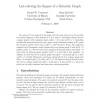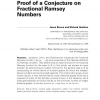63 search results - page 6 / 13 » Distance graphs with maximum chromatic number |
DM
2010
13 years 7 months ago
2010
Let Mad(G) denote the maximum average degree (over all subgraphs) of G and let i(G) denote the injective chromatic number of G. We prove that if Mad(G) 5 2 , then i(G) + 1; sim...
JGT
2008
13 years 7 months ago
2008
The square G2 of a graph G is the graph with the same vertex set as G and with two vertices adjacent if their distance in G is at most 2. Thomassen showed that for a planar graph ...
JGT
2010
13 years 5 months ago
2010
: Jacobson, Levin, and Scheinerman introduced the fractional Ramsey function rf (a1,a2, ...,ak) as an extension of the classical definition for Ramsey numbers. They determined an e...
DM
2010
13 years 7 months ago
2010
For graphs of bounded maximum degree, we consider acyclic t-improper colourings, that is, colourings in which each bipartite subgraph consisting of the edges between two colour cl...
DM
2006
13 years 7 months ago
2006
Let n(G) denote the number of vertices of a graph G and let (G) be the independence number of G, the maximum number of pairwise nonadjacent vertices of G. The Hall ratio of a grap...


